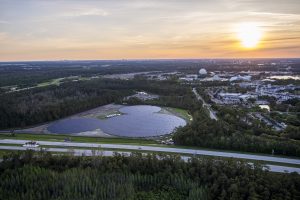


Environmental Goals
The Walt Disney Company is committed to taking meaningful and measurable action to support a healthier planet for future generations as we operate and grow our business.
Goals & Targets
Emissions
Water
Waste
Materials
Sustainable Design
Our Impact
The Walt Disney Company’s commitment to environmental stewardship goes back to our founding more than 100 years ago. Here are just a few ways we are focused on helping to protect the planet we all share.
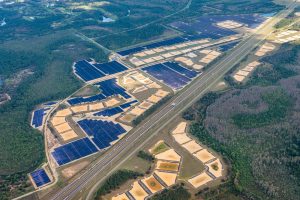
Reducing Emissions
Disney continues to research, invest in, and develop renewable electricity projects across our global portfolio, including investments in solar power at our parks and resorts in Paris, Orlando, Shanghai, and Hong Kong. For example, in collaboration with local utility providers at Walt Disney World Resort, a new 75-megawatt solar array came online in fiscal 2024. This array brings the site’s renewable electricity use up to 25% of its total electricity consumption.
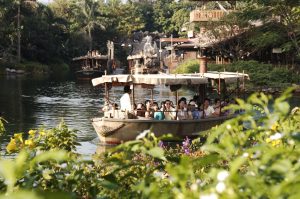
Conserving Water
Through water conservation efforts and use of reclaimed water, we are working to reduce potable water consumption at our operations. Recent efforts at our theme parks and resorts include EPCOT at Walt Disney World® Resort switching its irrigation system to reclaimed water and the Jungle River Cruise attraction at Hong Kong Disneyland refilling from collected rainwater.
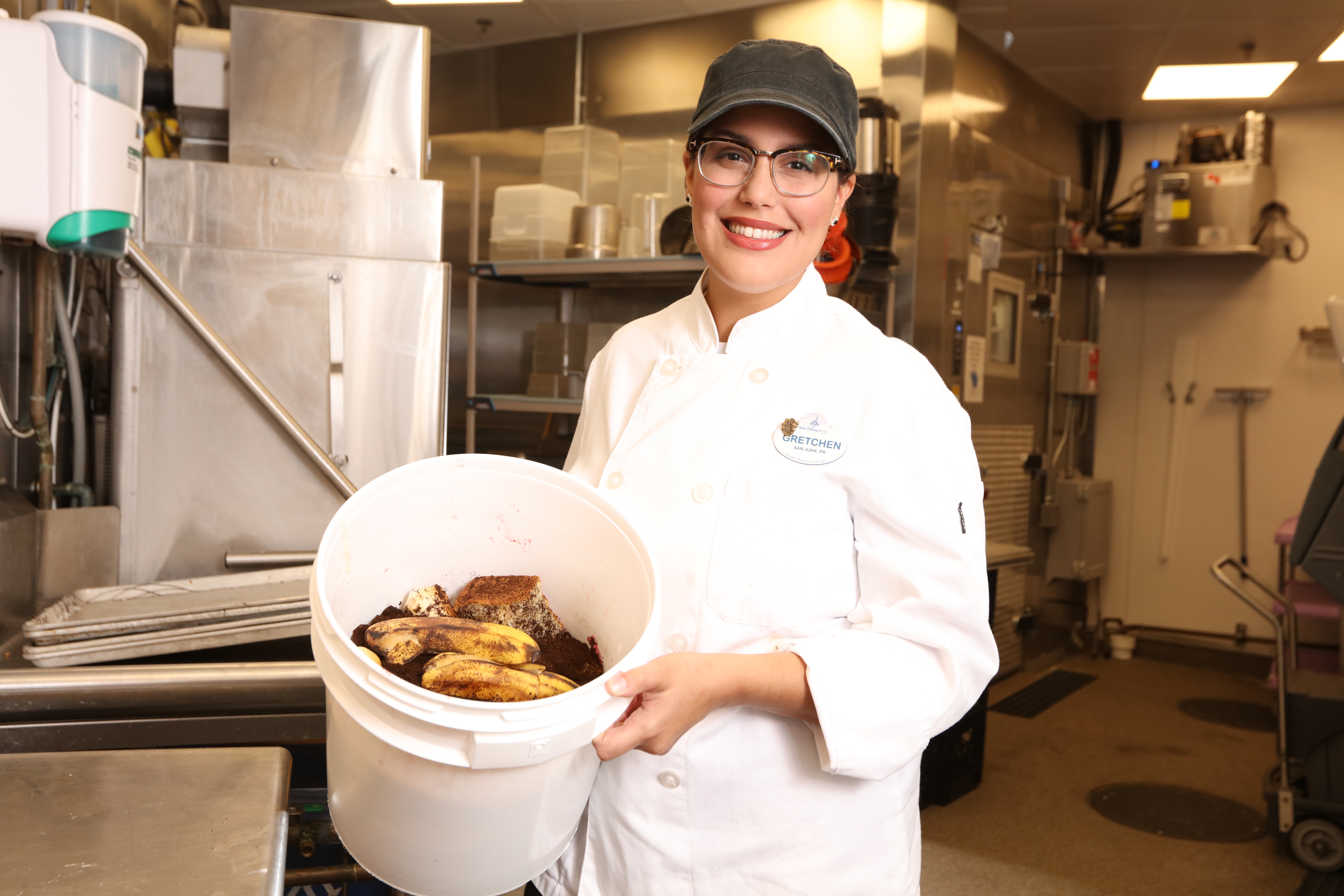
Reducing Waste
We have eliminated plastic straws and polystyrene hot beverage cups from Disney-owned or -operated parks and resorts. We’ve also expanded the use of reusable dishware at food and beverage locations, and are increasing substitutions of certified wood-based cutlery where we formerly used single-use plastic cutlery.

Lower Impact Products
We’ve expanded our plush product portfolio to include over 200 items made with at least 50% recycled materials. These plush products feature a special additional hangtag so guests can easily identify them. As part of our ongoing commitment to sustainability, we continue to find opportunities to incorporate recycled materials across our branded products.
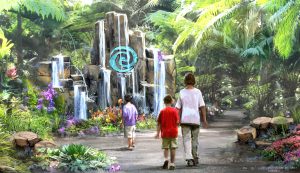
Building Sustainably
In collaboration with design teams across the company, and leveraging the creative expertise of our Disney Imagineers, we have established a set of internal Sustainable Design Standards, aligned with our 2030 goals.
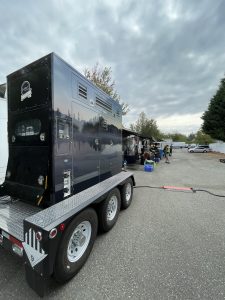
Sustainable Production
The Clean Mobile Power Initiative was launched in June 2023 with the support of Disney and Netflix to help film and television sets transition from traditional diesel generators to cleaner forms of energy. With support from RMI, formerly Rocky Mountain Institute, and its global climate tech accelerator, Third Derivative, the initiative aims to find, test, pilot, and help scale cost-competitive, zero-emissions mobile power designed specifically for film and television productions.

Protecting Nature and the Climate
For over a decade, Disney has invested in nature-based climate solutions. These natural places provide habitats for animals and resources for local communities, including food, shelter, and income, all while helping reduce the impact of climate change.
157K+
Tons of total company operational waste diverted from landfills in FY24*
38%
Progress toward reducing our absolute Scope 1 and 2 emissions**
15
Environmental Media Association Green Seal awards won in 2024
* For total company operational waste data, facilities include theme parks & resorts, Disney Cruise Line, ESPN, enterprise-owned commercial and office spaces, and Pixar. Excluded are all leased properties, Disney Stores and Distribution Centers, TV stations, and all construction materials.
** In support of our 2030 target, as of the end of fiscal 2024
2030 Environmental Goals
Reducing Our Emissions
Disney has had a long-term goal to achieve net zero greenhouse gas (GHG) emissions from our direct operations (Scope 1 and 2) since 2009, and we remain committed to this ambition. In alignment with the Intergovernmental Panel on Climate Change and the Paris Climate Agreement, we have now also set quantitative and timebound absolute reduction goals for emissions from our direct operations (Scope 1 and 2), and absolute reduction and supplier and licensee engagement goals for emissions from our value chain (Scope 3). In 2023, these goals were validated by the Science Based Targets Initiative (SBTi).
Emissions from our direct operations come primarily from energy use in our parks and resorts, major corporate campuses, and from fuel used by our cruise ships. Emissions in our value chain come from a wide range of sources, including manufacturing of consumer products, production of media content, and food and beverage operations.
Reducing Our Emissions*
Disney commits to:
- Reducing absolute emissions from direct operations (Scope 1 & 2) by 46.2% by 2030, against a 2019 baseline
- Achieving net zero emissions for direct operations by 2030**
- Purchasing or produce 100% zero carbon electricity by 2030
- Investing in natural climate solutions
- Reducing Scope 3 emissions through absolute reduction and supplier and licensee engagement
Protecting Water Resources
Water Stewardship: At Disney, we recognize that water is a highly local issue, with unique considerations in each geography. In keeping with the latest data and standards, seven of our highest-impact sites around the world will implement localized watershed stewardship strategies, focusing on both water conservation within our operations and investments to conserve and protect local natural water systems.
Sustainable Seafood: Responsible selection and sourcing of seafood is important to the future of our business, to the livelihoods of the fishing industry worldwide, and to the health of the planet for future generations. In fiscal 2024, our U.S. parks, U.S. resorts, and cruise lines sourced 96% sustainable seafood.
Protecting Water Resources
We are committed to:
- Implementing localized watershed stewardship strategies at key sites
- Sourcing sustainable seafood
Using & Wasting Less
Since 2009, Disney has made significant progress toward a long-term zero waste goal. We have undertaken a series of waste management initiatives to reduce, reuse, recycle, donate, and encourage behavior change initiatives with our guests and employees, in order to divert as much material as possible from landfills.
While we are proud of the progress we have made, we are committed to doing more. We will work to achieve zero waste to landfill for our wholly owned and operated parks, resorts, and cruise line by 2030. This will take the dedicated effort of our cast members and guests alike.
Using & Wasting Less
Disney is committed to working to:
- Achieve zero waste to landfill for wholly owned and operated parks, resorts, and cruise line by 2030
- Reduce single use plastics in parks and resorts
- Eliminate single use plastics on cruise ships by 2025
Sourcing Lower Impact Products
Disney brings stories and characters to life through innovative and engaging products from toys and t-shirts to books and games. We are committed to responsibly reducing the environmental impact of materials used in the creation and packaging of these items.
As a result of evaluating the impact we can have across our company-branded product portfolio, we identified a set of materials that are consistently used in high volumes and across a number of different product categories and/or are known to have significant environmental impacts associated with their production and use: forest products including paper, wood, and palm; textiles; and plastics. Our materials goals focus on reducing the environmental impacts of these materials while also helping our manufacturing network to become cleaner, safer, and healthier as a whole.
Sourcing Lower Impact Products
For Disney-branded products, by 2030, we commit to:
- Using recycled, certified, or verified sustainable paper, wood, and palm
- Using plastic that contains at least 30% recycled content or a lower impact alternative material
- Designing packaging for reuse, recycling, or composting
- Using recycled, sustainably sourced, or lower impact alternative textiles
- Having all facilities that manufacture products participate in the Higg index or maintain a sustainable manufacturing certification
Building for Lower Impact
In collaboration with our various design teams across the company, and leveraging the creative expertise of our Disney Imagineers, we have established a set of design standards that will guide the development of all new building projects. Whether it’s an office building, resort, film stage, or attraction, we will design all new construction to minimize waste, water, and energy in the construction and use of the building.
For the reopening of Mickey’s Toontown at Disneyland Park in Anaheim, California, the Café Daisy kitchen was completely redesigned to incorporate sustainability. All gas appliances were removed, and the kitchen now utilizes only electric equipment. The redesign increased the greenscape ratio and introduced recirculating water features that greatly reduce the land’s overall water use.
Building for Lower Impact
Our environmental commitments for new projects are to:
- Design new projects to achieve near net zero emissions, maximize water efficiency, and support zero waste operations
- Achieve 90% diversion of construction waste across new projects in the U.S. and Europe by 2030
* Our environmental goal-setting process adapts to changes in our businesses and in relevant protocols that we follow. For emissions, we measure actual emissions and forecast future emissions based on information available on our business plans, secular changes, projects, process changes, and other factors. We expect to follow SBTi methodology recommendations that companies check the validity of their target projections annually, and at a minimum, reassess targets every five years.
** We define “net emissions” and “net zero emissions” for our 2030 goals as follows: Scope 1 emissions + Scope 2 emissions (market based) – carbon credits. Market-based emissions are used where available in calculating carbon credit retirements, total emissions, and net emissions. Scope 2 emissions (market-based) include emission reductions attributed to utility green power purchases, power purchase agreements, and unbundled energy attribute certificates. Our approach to carbon credits can be found in our Natural Climate Solutions White Paper. We will have achieved our 2030 “net zero emissions” goal when “net emissions,” as defined above, equals 0.
***Note: Some of our environmental goals are requirements under European and French regulation. Regarding Disneyland Paris, learn more here.



